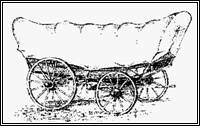The National Road
{The following article was compiled and written by Susan Guy}
In 1806 President Thomas Jefferson signed legislation officially establishing a national highway to run from Cumberland, Maryland to the Mississippi River, with the stipulation that it run through the state capitals of all states along its route. In 1811, the real work actually began.
The National Road was built in sections over four decades. In 1818, engineers reported the first major section was completed – the 113 mile stretch from Cumberland to Wheeling. In May of 1820 Congress appropriated funds to lay out the road from Wheeling to the Mississippi. Construction in Ohio didn’t commence until 1825.
Indiana’s route was surveyed in 1827, with construction beginning in 1829. By 1834, the road extended across the entire state. The road began to inch across Illinois in the early 1830’s, but shortages of funds and national will and local squabbles about its destination caused it to end in 1852, in Vandalia, Illinois rather than on the shores of the Mississippi.
The National Road opened up in the Ohio Valley and the Midwest for settlement and commerce. In the 1830’s and 40’s, the heavy continuous traffic on the road caused many a business to spring up along its route. Soon there were blacksmiths, livery stables, stores, hotels and inns. Through Pennsylvania and Ohio, there was an inn mile along the National Road. It was a continuous rumble of wagons and other contraptions of travel, people with their many children, farm animals and household goods in search of land and a new life. The dust never settled from morning till night.
In our area, the National Road runs through Washington County, Pennsylvania, through Wheeling, Ohio County, West Virginia, into Bridgeport, Belmont County, Ohio continuing west to Columbus, Franklin County, Ohio. The historic Blaine Bridge, in Blaine, Belmont County, Ohio was one of the main stops on the National Road for our ancestors to rest.

Forbes Road & The Raystown Path and The Old Trading Path
In 1758, General John Forbes convinced the Army to use the Raystown Path (Bedford) as a military road. Colonel James Burd had cleared the road to the east. However, the road was nearly impassable, so Colonel Boquet worked ahead of the advancing army to make improvements and widen the road bridle path or cut new paths over the hills. By November 24, the army reached Fort Dusquesne. In 1785, the State of Pennsylvania authorized the “Pennsylvania Road” from Harrisburg to Pittsburgh, following the old Forbes Road. The road was changed in many ways. It ran through Greensburg and took a south branch through Wilkinsburg. The Great Conestoga Road, completed in 1741, and the later Lancaster Pike (opened in 1794) went from Philadelphia to Lancaster. These two roads were linked and this was now the main migration route from the east to the Ohio Valley after the Revolution until the building of the Erie Canal in 1834. This road combined the Raystown Path from near Pittsburgh, to Harrisburg and the Allegheny Path to Philadelphia.
Zane’s Trace
In 1796, Colonel Ebenezer Zane petitioned Congress to authorize him to build a road from Wheeling to Limestone (Maysville), Kentucky. Congress awarded him a contract to complete a path between Wheeling and Limestone by January 1797.
The contract required him to operate ferries across three rivers as soon as the path opened. His only compensation was to be three 640-acre tracts of land, one at each river crossing, to be surveyed at his own expense.
Zane rounded up a crew equipped with axes and they blazed a trail. At first Zane’s Trace was merely a narrow dark path through the forest, between a wall of ancient trees. Only horsemen could travel over it. For many years it wasn’t wide enough for wagons. In 1804, Legislature appropriated about $15.00 a mile to make a new 20 foot wide road over Zane’s route.